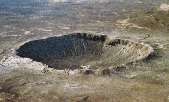ASTR220 SYLLABUS


Collisions in the Solar System
Tuesday Feb. 1
-- Introduction & Survey of the Universe
Course description and expectations
Collisions within the solar system, our Galaxy, and the universe
Time scales and spacings
Video: Powers of Ten (in class presentation)
Reading: Chapman & Morrison 1
Thursday Feb. 3
-- Impact Craters on Earth
Scientific Method
Volcanic versus impact theories
Tunguska event
Reading: Chapman & Morrison 2 & 3
Tuesday Feb. 8
-- Bombardment of the Solar System
Observations and comparison of surfaces
Why planets and moons look so different
Reading: Chapman & Morrison 4
Thursday Feb. 10
-- Factors Affecting Surfaces
Orbits, composition, collision potential
Reading: Chapman & Morrison 5 to page 70
Video: Flying by the Planets (in class presentation)
Tuesday Feb. 15
-- Nature of Projectiles - Comets,
Asteroids, and Meteorites
Orbits, composition, collision potential
Reading: Chapman & Morrison 5 from page 70
HOMEWORK #1 due at beginning of class
Thursday Feb. 17
-- Experiences with Collisions
IN CLASS ACTIVITY (15 pts.) Making Craters
Tuesday Feb. 22
-- Comet Shoemaker-Levy 9 Collision with Jupiter
Discovery and Observations
MPEG movies of the Impacts
Reading: Chapman & Morrison 6
Thursday Feb. 24
-- The Asteroid Impact Theory of Dinosaur Demise
Birth of a new theory
Impact Winter / Nuclear Winter --- what would it be like?
Video: Crater of Death (in class presentation)
Reading: Chapman & Morrison 7 & 8
Tuesday Feb. 29
-- Periodic Mass Extinctions
Nemesis, Kuiper Belt, Oort Cloud
Reading: Chapman & Morrison 10 & 11
Thursday Mar. 2
-- Formation of the Earth's Moon
Result of a collision?
Other Theories Involving Major Solar System Collisions:
Mercury, Uranus, Miranda, Pluto
Reading: Chapman & Morrison 12 & 13
QUIZ #1 given in class
Tuesday Mar. 7
-- Predicting and Preventing Collisions:
Do future collisions threaten our existence?
NOVA video (in class presentation)
Reading: Chapman & Morrison 19
HOMEWORK #2 due at the beginning of class
Thursday Mar. 9
-- So What Do We Do?
Watch programs & Action programs
IN CLASS ACTIVITY (15 pts.) Killer Asteroid Discussion
Tuesday Mar. 14
-- EXAM I
Collisions between Stars
Thursday Mar. 16
-- Physics of Light and Heat
Electromagnetic spectrum
Blackbody radiation
Doppler shift
Week of Mar. 20
-- Spring Break
Tuesday Mar. 28
-- Properties of Stars
Observations and theories
The Hertzsprung Russell Diagram
The Main Sequence
Reading: Chapman & Morrison 17
Thursday Mar. 30
-- Evolution of Stars
Life of the Sun: Evolution of a 1 solar mass star
High mass stars
Synthesis of the elements
Tuesday Apr. 4
-- Stellar Death
Supernovae
White dwarfs, neutron stars, and black holes
Reading: Chapman & Morrison 18
QUIZ #2 given in class POSTPONED until 4/6/00
Thursday Apr. 6
-- Binary Stars
Characteristics and types
Close Binaries
Mass flows and novae
Fascinating systems: Algol, Cygnus X-1, SS 433, ER Vulpeculae, models
QUIZ #2 given in class NEW TIME
Tuesday Apr. 11
-- Star Clusters & Galactic Structure
Open and globular clusters
Do stars collide?
Survey of the Milky Way Galaxy
HOMEWORK #3 due at the beginning of class
Thursday Apr. 13
-- EXAM II
Tuesday Apr. 18
-- ET & X-files
IN CLASS ACTIVITY (15 pts.) Extraterrestrial Life Discussion
Collisions between Galaxies
Thursday Apr. 20
-- External Galaxies
Discovery and implications
Cepheid Stars and Distance Scales
[Reading: Parker 1, 2, 3]
Tuesday Apr. 25
-- Galaxy Morphology
Galaxy classification: the Hubble Sequence
Peculiar & Interacting Galaxies
Thursday Apr. 27
-- Radio Galaxies, Seyferts, & Quasars
Discovery and energy scales
The Supermassive Black Hole Model
Does our Milky Way have a supermassive black hole lurking
at its center?
[Reading: Parker 4, 5, 6]
Tuesday May 2
-- Galactic Collisions
Observations and theory
MPEG movies of interacting and merging galaxies
[Reading: Parker 9, 10, 11]
HOMEWORK #4 due at the beginning of class
Thursday May 4
-- Large Scale Structure
Galaxies, Clusters of galaxies, Superclusters
Bubbles and Voids
[Reading: Parker 12 & 13 to page 266]
QUIZ #3
Tuesday May 9
-- Cosmology
Possible fates of our universe
The Ultimate Collision--The Big Crunch?
[Reading: Parker 13 & 14 from page 266]
Thursday May 11
-- Dark Matter in the Universe
Evidence for and nature of dark matter
Does it really exist?
Tuesday May 16
Latest Results in Cosmology & Dark Matter
Other Collisions in Space & things that go bump in the night:
Gamma Ray bursts: Colliding Neutron Stars?
Review
Saturday May 20
-- FINAL EXAM
Room: CSS 2400
Time: 10:30 am - 12:30 pm
 Return to ASTR220 Home Page
Return to ASTR220 Home Page
Last modified: Wednesday January 26, 2000
 Return to ASTR220 Home Page
Return to ASTR220 Home Page 

 Return to ASTR220 Home Page
Return to ASTR220 Home Page